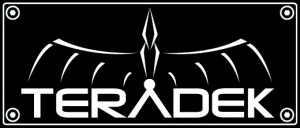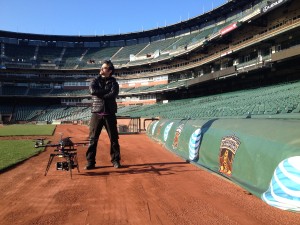Case Study: Fan Experience Goes Aerial Using Drone and Teradek Technology
Story Highlights
For UAV pilot Matthew Lavin, improving the fan experience during a major sporting event is no easy task. As owner of the live aerial production company Aerography, Lavin knew that integrating his drone technology with sports-video broadcasting could create a fresh, exciting point of view for sports fans worldwide.
With this goal in mind, he partnered with the San Francisco Giants back in 2013 in an attempt to test out this aerial approach during a live event. However, one of the biggest challenges that he faced involved getting an uninterrupted, high-quality feed from a drone 300 feet in the air while retaining a broadcast compatible signal to weave into the A/V workflow.
 “It was essential to get a long distance, latency-free HD feed with a lightweight platform like a drone. But we were kind of at a loss because the technology had to be there,” says Lavin. “At the time, I was searching for new trendsetters that were starting to bring this technology to the market or else this project wasn’t going to work out.”
“It was essential to get a long distance, latency-free HD feed with a lightweight platform like a drone. But we were kind of at a loss because the technology had to be there,” says Lavin. “At the time, I was searching for new trendsetters that were starting to bring this technology to the market or else this project wasn’t going to work out.”
The Drone Workflow
At the end of his search, Lavin decided to use Teradek’s Bolt Pro 2000 as his drone’s wireless transmitter, mostly because of the Bolt’s uncompressed, zero-delay signal with 4:2:2 color sampling. Having a range up to 2,000 feet, Bolt also includes easy color management that allows any camera color profile to be brought back to a REC 709 color space or customized to match. To meet broadcast standards, Lavin would use Bolt’s in-line standards converter to ingest up to 1080p60 via SDI and output the ideal frame rate and resolution for his feed.
 “Teradek was one of the only companies that could deliver the quality that the Giants needed,” remarks Lavin. “With everything that was going on, we were still able to get the feed that we needed from the Bolt and, in turn, use their Cube to get that broadcast quality that we needed.”
“Teradek was one of the only companies that could deliver the quality that the Giants needed,” remarks Lavin. “With everything that was going on, we were still able to get the feed that we needed from the Bolt and, in turn, use their Cube to get that broadcast quality that we needed.”
By easily merging with the robust infrastructure already in place at AT&T Park, Lavin and the rest of his Aerography team could utilize the Teradek Cube encoder and decoder to distribute the SDI video signal from the Bolt receiver through IP. With IP, he could pass his signal across a variety of ports and mediums, making it extremely easy to distribute the video signal.
Since FAA regulations started to get tight around this time, Lavin realized that he needed to position the drone further away, putting him outside of the stadium’s network range. Fortunately, Aerography used Teradek Bond II for its cellular bonding, which let him send high-definition video through multiple cellular signals to ensure ample bandwidth and reliability.
From here, the video is then routed through Core, Teradek’s cloud management system. With this last piece of the puzzle, Lavin could just drag and drop the signal back to the Cube decoder so it can be mixed with the main switch.
“Being able to stream and broadcast an HD feed wirelessly from a drone with the Teradek workflow is pretty amazing,” he says. “For this market, the drone is unique. This perspective and the technology involved fascinate people and the fans love it. We get to give them this richer, more intimate experience with their team and it’s a great feeling being able to provide that.”
Challenging Innovation
By the beginning of 2014, the FAA started to hit hard and enforce legitimate flight restrictions prohibiting drones, airplanes, and even helicopters from flying over any MLB, NASCAR, NFL, or college football stadium. With these new boundaries in place, Lavin’s aerial experience for the San Francisco Giants’ fans is at a stalemate, even after proving the detailed workflow.
 To this day, there is no surefire way to gain permission from the FAA to provide this service for sports organizations that want it. According to Lavin, the lack of regulations and the reluctance to use new technology has crippled live aerial HD broadcast.
To this day, there is no surefire way to gain permission from the FAA to provide this service for sports organizations that want it. According to Lavin, the lack of regulations and the reluctance to use new technology has crippled live aerial HD broadcast.
“As broadcasters, we’re trying to bring this immersive experience into the home and it has the potential of being even better than seeing it live,” says Lavin. “Unfortunately, you get a lot of pushback when you’re trying to innovate and you’re going to have to swim upstream for a while. The hurdles right now are bureaucratic, but once that gets cleared away people will really start to see what this technology can bring to the table.”
